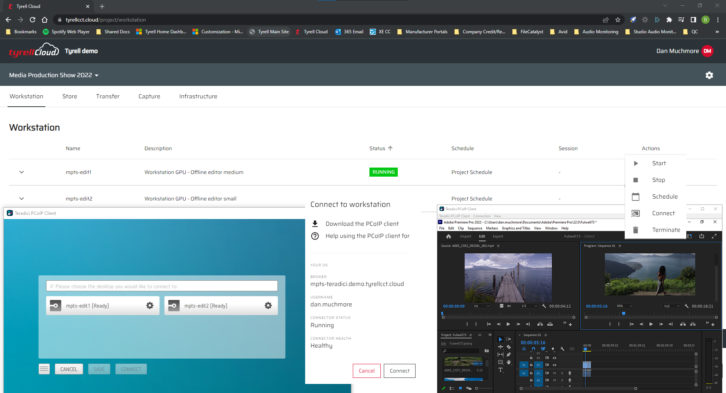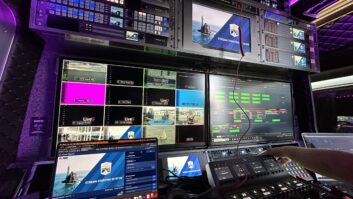The media and entertainment industry’s evolving rapidly. When Covid struck two years ago, the production community had to come up with new ways of working to not only film and ensure safe practices for talent and crew, but also to adopt new workflows so that content could be edited and managed remotely. Despite the massive challenges that the pandemic created, we’ve witnessed the use of incredible technical innovations (think remote production and remote working) that have resulted in quantum creative leaps across our industry.
UK-based production company Mallinson Sadler Productions (MSP) was started in 2002 by childhood friends Crispin Sadler, a multiple award-winning documentary maker and Simon Mallinson, a multiple award-winning advertisement and film maker. They produce factual, ocean-themed programmes for a wide range of broadcasters all over the world with technical innovation at the forefront of their productions.
Over the years, MSP successfully took care of its own editing. In the early days as its production grew, it needed more engineering and the support of post houses. During lockdown, the team created 20 episodes of one of its popular shows and was heavily reliant on the post house during this time. Ken Robinson, technical manager, MSP says, “The pandemic and lockdown was a difficult time for everyone. The post house had to go through radical change and we found ourselves part of the teething problems in the workflow challenge that they had. As in all post houses there is never just one client, so delays were further compounded by lack of booking slots to complete important tasks. Staff aren’t assigned to one client and so little things such as file labelling could go wrong, causing problems later when auditing content.”
Time for change
MSP started looking for alternative workflows that would help resolve these issues. It needed six edit suites spread across two buildings in Bristol. Robinson says, “I was trying to figure out how to connect everything together and how to make it work reliably. It’s fine to say, ‘let’s build our own edit suites’, but you have to understand what that really entails without spending a fortune.” Luckily he didn’t have to pursue this idea any further: “A colleague of mine said his supplier Tyrell might have an interesting solution. I jumped on a call and was pretty much sold straight away.”
Robinson was referring to Tyrell Cloud, a set of services powered by leading manufacturers that allow anyone involved in content creation to take advantage of the power and agility of the cloud without the often-associated runaway cost or steep learning curve. Earlier this year the company successfully demonstrated the ingest of live SRT streams with Cinedeck directly to EditShare storage and more vendor solutions will be announced soon.

Bryan Malone, Tyrell’s MD says, “The cloud is the new technical frontier that allows us to rethink how we approach the next-generation of content creators. Using Tyrell Cloud, media companies have a turnkey managed service based on their project workflow requirements, which gives instant access to solutions from multiple vendors. Today, a Tyrell Cloud customer can enjoy an offline editorial experience with EditShare FLEX and AWS (Storage), FileCatalyst (File transfer) and Teradici (Virtual workstation control).
“AWS’ values are closely aligned with Tyrell’s. We did try other public cloud providers, but none have the media and entertainment customer and market focus that AWS does. Also, it’s our preference to be multi-region rather than multi-public. We believe it provides more value to our customers to support a production in any country. We want to be able to offer file or stream ingest at the closest AWS point and provide the lowest latency editing experience possible with multi-region support. Security is our absolute concern. By employing the latest AWS secure architecture, we can offer our customers the confidence that their content is more secure than an on-premise solution.”
The efficiency of Tyrell Cloud
Tyrell Cloud provides MSP and other clients with a way of facilitating remote working in a more sustainable way, bringing technology closer to the talent rather than the traditional travel to the centre of the city and completely turns the economic model of post production on its head. Tyrell Cloud allows facilities to expand and contract its technical estate freely when required and migrate their workflows to the cloud without ever seeing the cloud or needing any experience in the cloud.
Anyone on the production project team can access and manage content in the Tyrell Cloud environment without needing technical cloud skills. It allows freelance editors working remotely to edit content in the cloud; they simply need the server address to log in. Robinson says, “It doesn’t matter where the editor is if they’ve got at least a 20-50-Mbps connection. Our editorial is extremely important, and my goal is to make the technology work so that editors can focus on the creative task. We don’t need editors who have deep technical knowledge; we need editors who have very good storytelling abilities.”
Tyrell Cloud customers can also choose a hybrid version. MSP, for example, has an EditShare both on-prem and in the cloud. The EditShare on-prem is used to store the proxies on watch folders to be uploaded to each edit. It allows Flow to scan, so all the material is available to see on the Airflow web interface. Robinson adds “This whole story was an alignment of the stars. We’d already invested in EditShare, because we’d previously edited in house and are using the Airflow MAM to allow remote access to hundreds of terabytes of material. In addition we use an LTO 8 library to back up as we ingest. Using Tyrell Cloud, we were able to limit six edit suites to 13-15 terabytes of total storage. Plus, content only goes one way to the cloud; we send it up, but we don’t pull it back down because we have everything on prem. The content on the cloud is only used for editing.”
For the editors themselves, they don’t notice any difference. Robinson says, “It’s the same as if they were in an edit suite. The other beauty is we have one edit assistant who’s able to ingest, transcode and look after each of those six cloud-based edit suites. Because we’re our own client, unlike a post facility, we’re not dealing with 20 other customers all screaming to have their content ingested. We’re able to receive shoot drives at 9am, sync, transcode and have everything available for the edit by lunchtime the next day.”
The Tyrell Cloud platform allows customers to determine when services run down to the hour, removing the fear of runaway costs. Customers are always in full control. Using Tyrell Cloud, media companies can migrate away from the annual capex and align production costs to their specific production schedules running production servers when they are required rather than investing ahead of time regardless of commissioning cycles.
For MSP, Tyrell Cloud gives them back control of their productions. Robinson adds, “At the end of the production, I have peace of mind knowing everything is there— knowing it’s labelled accurately and stored and that we can quickly and easily find it at any time.”







